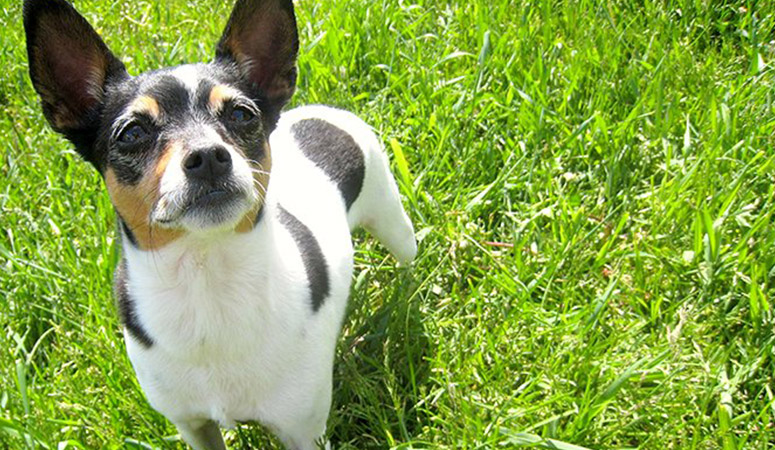Rat Terrier

As an American dog breed, Rat Terrier has a background as a farm dog and hunting companion. Coming in two size varieties, the breed is intelligent and active with balanced and compactly built, which is kept both for pest control and as a family pet.
| Other Names | American Rat Terrier, Benchlegged Feist, Rat Terrier Type A, Rat Terrier Type B, Teddy Roosevelt Terrier |
| Color | Black & White, Black, Tan, Chocolate, Blue, Grey Isabella, Lemon & Apricot. May be tri-color or bi-color, with at least one color being white. |
| Height | Males: 13-18 inches. Females: 13-18 inches. |
| Weight | Males: 12-35 pounds. Females: 12-35 pounds. |
| Life Span | 12-18 years |
| Personality | Friendly, Inquisitive, Lovable |
| Exercise | Regular Exercise |
| Origin |
| Popularity | #91 |
| Groom Needs | Weekly Brushing |
| Kids Friendly | Yes |
| Dog Friendly | Yes with supervision |
| Watch Dog | |
| Family Dog | |
| Litter Size | 5 to 7 puppies |
Rat Terrier Pictures
Rat Terrier Video
Introduction
Revered for their unmatched ratting ability are the Rat Terriers, a breed name that says almost everything about it. They belong to the Terrier Group according to the American Kennel Club. The smooth and shiny coat of the Rat Terrier carries different pied varieties of patches, likened to those of a horse. They come in a variety of colors, including blue, black, tan, chocolate, pearl, or lemon, and apricot. Bi- and tri-colored varieties exist, of which one of the colors was usually white. Greyhounds and Whippets crosses are thought to be the origin of the blue Rat Terriers.
The Rat Terrier is peculiar in that it appeared in two different sizes, both acceptable — miniature and standard sizes. A miniature Rattie stands 10-13 inches at the shoulder while a standard one rises above it to around 14-18 inches of height, encompassing both sexes. The standard weight is usually between 11 and 25 pounds. The Rat Terrier is a compact, tough bred dog with a friendly and charismatic disposition. They lead happy lives up to an average of 12-18 years before they die of age.
Living with Rat Terrier
With short, dense coat, the Rat Terrier requires very little care to keep him in good condition. Shedding is heavier in the spring and fall, as well as after whelping or heat cycles. Weekly brushings with a soft brush or a rubber curry mitt can help remove loose hair. A bath every month or so will likely be enough, depending on the dog’s lifestyle.
Start to get your Rat Terrier used to being brushed and examined when he’s a puppy and make grooming a positive experience filled with praise and rewards which will make the groundwork for easy veterinary exams and other handling when he’s an adult.
Trim his nails once or twice a month to prevent painful tears and other problems. With blood vessels in the dog toenails, you should not you cut too far and ask a vet or groomer for pointers, or you can cause bleeding, which may lead to low cooperation of your dog next time he sees the nail clippers come out.
Brush your Rat Terrier’s teeth at least two or three times a week to remove tartar buildup and the bacteria that lurk inside it. Daily brushing can help more if you want to prevent gum disease and bad breath.
His ears should be checked weekly for redness or a bad odor, which can indicate an infection. You should wipe his ears out with a cotton ball dampened with gentle, pH-balanced ear cleaner to help prevent infections when you check them.
The Rat Terrier as plenty of energy to spare. Exercise of at least 40 minutes will help him keep healthy and happy. With enough exercise and mental stimulation, they’re more than willing to cuddle up inside with their people, or they may become destructive and bark excessively.
Take your Rat Terrier for walks a few times a day, or take him to the dog park to work off all that excess energy. If you live on a farm, this breed will go to work keeping the rodent population in check.
With a strong prey drive, time spent outdoors should be on-leash and supervised, as most Rat Terriers will not be able to resist the urge to chase when faced with a strange cat or squirrel. This breed is not suitable for living outdoors full-time, and should never be left unsupervised.
They have a great desire to please, love praise, and will follow you around the house. And there’s nothing that the Rat Terrier likes more than to play catch for hours on end.
Earthdogging exercises may harness the Rattie’s prey drive in a non-hunting capacity.
The Rat Terrier needs high-quality dog food whether commercially manufactured or home-prepared to meet his nutrition needs with your veterinarian’s supervision and approval.
Rat Terriers may guard their food or be territorial around other pets or people, and children should never be allowed to touch or remove food while any dog is eating.
The amount of a high-quality dog food that you give should be different according to its age, size, activity level and metabolism. And the quality of the food also makes a difference.
Never give too much food to prevent obesity and keep your Rat Terrier in good shape. Clean, fresh water should be available at all times.
You can change a puppy’s diet, but this needs to be done very gradually always making sure they don’t develop any digestive upsets. Older dogs are not known to be fussy or finicky eaters, but this does not mean you can feed them a lower quality diet. You’d better feed a mature dog twice a day, rather than leaving the food out all day long to make sure that the food meets all their nutritional requirements.
Learn about which human foods are safe for dogs, and which are not. If you have any concerns about your dog’s weight or diet, check with your vet.
Rat Terriers are generally healthy, but they have the potential to develop genetic health problems, just like many other dog breeds. Breed health concerns may include hip dysplasia, patellar luxation, allergies and skin conditions, heart concerns, epilepsy, eye diseases, dental concerns and deafness. Responsible breeders screen their stock for these health conditions.
It’s important to be aware of them if you’re considering this breed. A reputable breeder will be honest and open about health problems in the breed and the incidence with which they occur in her lines.
A conscientious breeder takes his dog to do health tests regularly, such as cardiac exam, hip evaluation, ophthalmologist evaluation and patella evaluation.
Total Annual Cost: $2674
Cost is estimated for the first year and may vary depending on many factors, such as dog food, health care, leash, collar, licensing, possible fencing, crates, training and obedience classes, dog-walking, grooming, treats, toys, flea, tick, and heart-worm meds, microchips, etc.
Intelligent and trainable, sometimes stubborn and determined, the Rat Terrier excels in agility, obedience, rally, and other canine sports. Anything you can do to keep these dogs occupied is helpful, as it keeps both their minds and bodies active and engaged.
They love to please their owner with sensitive and intuitive character, and most of them are patient and tolerant of children but may be reserved with strangers.
Early socialization and puppy training classes are recommended to help ensure that your Rat Terrier puppy grows up to be a well-rounded dog and a calm, well-behaved companion. Inviting visitors over regularly, and taking him to busy parks, stores that allow dogs, and on leisurely strolls to meet neighbors will also help him polish his social skills.
They hey thrive on praise and respond quickly to positive training methods. Short, fun, varied training sessions work best for this easily-bored breed. Basic obedience, good leash manners, and an emergency recall should be top priorities.
Crate train your Rat Terrier if you wish to leave the puppy out when he reaches adulthood, but never stick your Rat Terrier in a crate all day long. Rat Terriers are people dogs, and they aren’t meant to spend their lives locked up in a crate or kennel.
Rat Terriers have been trained for police departments—their small size lets them fit into tight spaces, and their keen noses allow them to expertly sniff out drugs, explosives and people.
History
Developed from a mixed breed of vermin hunting dogs, originally called Feists, the Rat Terrier was so named probably by President Theodore Roosevelt who had about three of this breed dog, the most popular, named Skip. He was said to have been enamored with his dogs and called them Rat Terriers, fascinated by the unique prowess and skillful dispatch with which dogs of this breed exterminated rats. They later grew to a place of importance in American and English farms around the early to mid 20th century as rats were a constant sight in the barns and sheepfolds and needed some taking care of.
Their history has most probably begun in the 1820s. Modern Rat Terriers emerged from a number of crosses to improve an initial foundational stock of Feists. These Feists had resulted probably from the popular cross between a Smooth Fox Terrier and a Manchester Terrier. Like their Feist ancestors, the Rat Terrier had uncommon expertise in hunting and ratting.
The beginnings of the Rat Terrier are credited with 19th century England, after which it was hugely developed in the United States. Around the latter part of the 19th century leading up to the turn of the 20th century, certain British miners traveled from their homeland to the United States, on business. History holds that these miners brought their Feist dogs with them. It was after this period that the Feists were repeatedly crossed with other breeds to add some attributes to their gene pool. Amongst the breeds, it was crossed with includes mainly the Smooth Fox Terrier, which served in stabilizing the core attributes of the Rat Terrier breed. Hence, the modern Rat Terrier began to unfold slowly to what we have today. Greyhounds and Whippets had gone into the breeding of the modern breed to improve their speed.
Helpful Information
Breed Club: RAT TERRIER CLUB OF AMERICA
Breed Club Link: https://ratterrierclubofamerica.org/
Breed Club Rescue: New Rattitude, Inc.
Breed Club Rescue Link: http://www.newrattitude.org/




